Why Frack Wastewater Injected Underground Doesn’t Always Stay There by Julie Grant, March 19, 2021, The Allegheny Front
Salty wastewater produced by fracking for oil and gas has to go somewhere. Often, it’s injected into disposal wells deep underground. But sometimes that wastewater can find its way back to the surface and cause environmental problems.
How? We turned to three experts to find out.
A Quick Geology Lesson
The layers of earth beneath Ohio and Pennsylvania are evidence of the region’s natural history over hundreds of millions of years.
“Things get wet, then they get dry. They’re lakes and then they’re deserts. That’s our past, that’s our future,” explained Tony Ingraffea, professor emeritus of engineering at Cornell University, who has worked with the energy industry.
Class II wells are used to inject fluids from oil and gas production, thousands of feet below the surface, isolated from underground sources of drinking water. Image: U.S. EPA
Those “lakes” were salty water, and the mud and silt at the bottom were compressed over time into layers of the flaky, but tightly packed rock called shale.
Meanwhile, on the surface, this region became more like a desert.
“And what do you have in a desert?” Ingraffea asked. “Sand.”
Sand accumulated for many millions of years, creating a hard, but porous rock called sandstone. The cycle repeated many times, resulting in layers of shale and sandstone.
Dead fish and plants caught in the shale layers eventually transformed into natural gas and oil, which over time migrated from the shale and became trapped in the pores of sandstone, creating reservoirs of oil and gas.
When people first started drilling for oil in the 1800s, they found it in the sandstone layers.
The Many, Many Wells in Ohio and Pa.
In Pennsylvania, hundreds of thousands of oil and gas wells have been drilled, tens of thousands in Ohio. Often, if they stopped producing, they were abandoned.
“Pennsylvania and Ohio are the two states with the oldest wells and probably the highest density of wells, especially these really old wells,” said Susan Brantley, professor of geosciences at Penn State University, who studies the movement of fluids underground.
In recent years, another type of well has become common: fracked shale wells, which can be drilled to 9,000 feet or more below the surface.
According to Brantley, about 12,000 fracked shale wells have been drilled in Pennsylvania in the last 15 years or so. Drillers use millions of gallons of water mixed with sand and chemicals at high pressure to crack the deeper Marcellus and Utica shale formations, releasing the oil and gas.
Salty wastewater called brine also flows up to the surface.
“Some people say the oil and gas industry, they should call it a water industry because every oil and gas well brings up water with the oil and gas,” said Brantley.
That chemical-laced wastewater can be toxic and radioactive.
Often it gets disposed of in another type of well: disposal wells, called Class II injection wells, where wastewater is injected back into the earth.
Pennsylvania has only nine of these, with a handful more on the way. That leaves millions of gallons of Pennsylvania’s waste that are trucked to Ohio’s 226 injection wells.
A Swiss Cheese Landscape
Injection wells, oil and gas wells, and older, abandoned wells are oftentimes all in one area.
“When you have this many wells in the landscape that makes the landscape Swiss cheese,” said geologist Terry Engelder, Penn State professor emeritus. Engelder’s work earned him the nickname “Father of the Marcellus Shale.”
Injecting wastewater into underground rock layers could create problems if there are a large number of wells in the vicinity.
Consider porous sandstone, which has tiny spaces in the rock. Liquid under high pressure like fracking wastewater can find those spaces in the sandstone and travel underground. And if the wastewater meets a well, it can rush up to the surface. ![]() In Alberta, Encana/Ovintiv and other companies, are frac’ing sands, shales, coals, often commingled in one well (intentionally to feed the profit greed, and prevent accurate fingerprinting of trespassing gases migrating or shooting up to the surface via the ground, into other wellbores and water wells. Refer to the additional files below). One doesn’t need to be a scientist to understand migration of gases and toxic frac chemicals when frac’ing porous formations.
In Alberta, Encana/Ovintiv and other companies, are frac’ing sands, shales, coals, often commingled in one well (intentionally to feed the profit greed, and prevent accurate fingerprinting of trespassing gases migrating or shooting up to the surface via the ground, into other wellbores and water wells. Refer to the additional files below). One doesn’t need to be a scientist to understand migration of gases and toxic frac chemicals when frac’ing porous formations.![]()
This movement is called migration.
In part to avoid migration, injection well operators in Ohio and Pennsylvania are required to identify and possibly plug abandoned wells up to a half-mile radius, although two recent incidences show that wastewater can travel much further than that.
Brine Migration in Ohio
Just last month, an unused gas well in Noble County, Ohio started spewing salty brine water. According to the Ohio Department of Natural Resources (ODNR), more than 1.5 million gallons of the wastewater were collected, but not before enough escaped into a nearby creek to kill fish and salamanders.
Engelder examined state records and thinks that brine spray was wastewater from a nearby injection well.
The injection well and the unused well were drilled into the same underground rock formation, a sandstone layer nearly 6,000 feet underground.
“It flowed along the Medina [sandstone] 2.54 miles, and then back up,” he said. He also theorized that the wastewater also could have come from another injection well in the Medina sandstone nearly four miles away.

This map shows oil and gas wells near the unused well that spewed brine wastewater. The blue dots show the injection wells which are used to dispose of fracking wastewater. Data are from ODNR Division of Oil and Gas and Underground Injection Control (UIC) program. Map courtesy of FracTracker Alliance.
Drilling an injection well into the same layer as other oil and gas wells makes wastewater migration more likely, according to Engelder.
He looked at a sample of 35 injection well depths in Ohio and found many were drilled to the Medina sandstone layer, the same layer as many older, abandoned oil and gas wells.
In another migration incident in 2019, in Washington County, Ohio, ODNR concluded that brine from an injection well drilled into shale migrated into an adjacent layer of sandstone, contaminating multiple gas wells five miles away.

Terry Engelder examined 35 injection well depths (shown as red stars) in Ohio and found the majority are drilled to the Medina sandstone layer, the same layer as many older, abandoned oil and gas wells. The red lines are gamma ray logs from two wells. When the red line moves to the right, it indicates more radioactivity. Image courtesy of Terry Engelder.
What About the Drinking Water Supply?
…
But Penn State’s Susan Brantley said that many older wells in Ohio and Pennsylvania were not built to those standards.
“The older the well, the higher the likelihood that there could be some cracking in the cement,” she explained, causing a risk of groundwater contamination.
She pointed to the Noble County incident, where brine migrated to an older, unused well and came up to the surface.
“[The older well] is going through the freshwater zone, and then the brine came back up through the well,” she said. “This is an old well, so I don’t know how well cased it is.”
However, there is no evidence that brine wastewater contaminated groundwater in that incident.
More Injection Wells, More Migration?
Cornell’s Tony Ingraffea expects more injected wastewater to find its way to the surface.
“Because the more holes you drill in the ground, the more injection wells you have, and the more wells that you have that are being abandoned but not properly plugged, the higher the probability that the events that you’re witnessing in Ohio are going to be repeating again and again,” he said.
Brantley isn’t as concerned. “I’m not really sure you can say that there’s so many wells that they’re just going to start spewing all over the place,” she said.
But with all the fracked shale wells now, she’s not sure how regulators can prevent brine migrations to the surface.
“You’ve got 12,000 new wells, and then you may have hundreds of thousands of old wells. What would due diligence be?” she asked. “How many people would you need with feet on the ground looking at this to really figure it out precisely when we cannot predict where a fracture is going to go?”
Modern fracking in these ancient shale layers quickly took hold in the industry, but people are still learning the impacts of all the waste it creates, according to Brantley.
“We innovate faster than we can figure out what the implications are, that is just a true statement about humans, right?” she said.

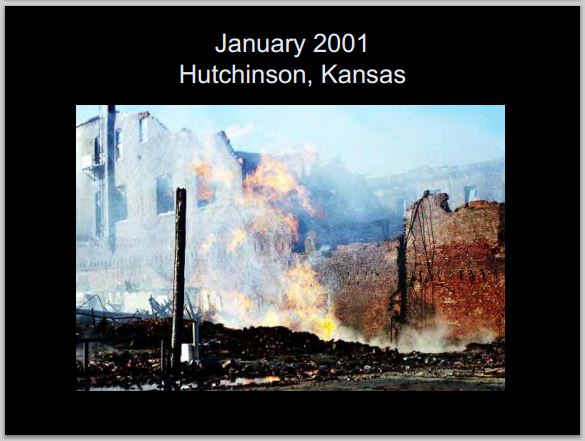
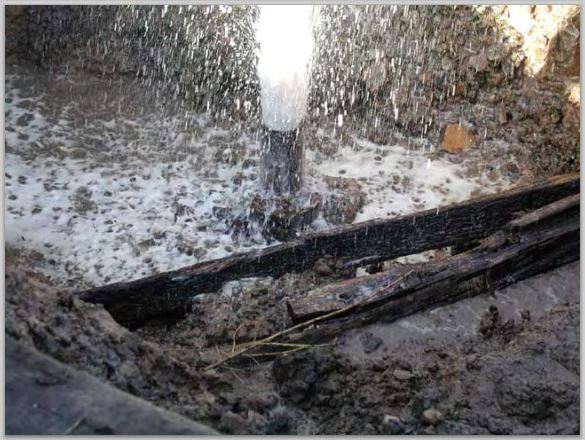
A water well in Hutchinson, spewing migrating gases
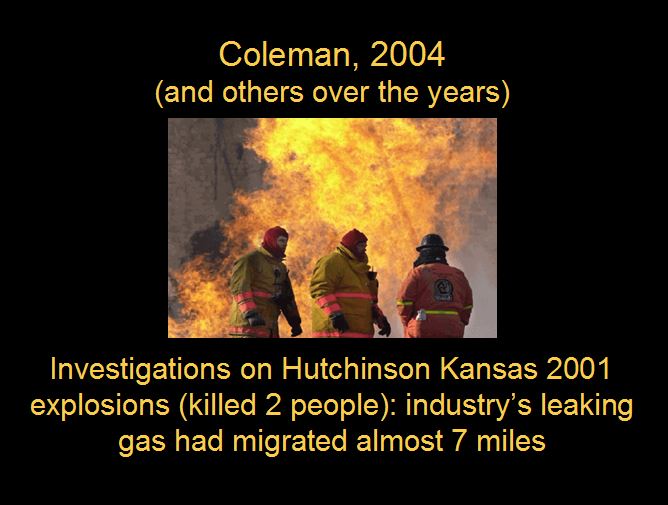
A few Alberta examples:

~2004/2005: Shallow “Involuntary Stimulation” frac out events, from EUB (ERCB/AER) library
2006 01 31: Directive 027: Shallow Fracturing Operations-Interim Controls ![]() After I went public with this damning regulator admission, the regulator removed the directive from public access, edited out the most damning parts, and reposted it altered – in true corrupt Alberta oil patch fashion. I uploaded these vital documents to my website.
After I went public with this damning regulator admission, the regulator removed the directive from public access, edited out the most damning parts, and reposted it altered – in true corrupt Alberta oil patch fashion. I uploaded these vital documents to my website.![]()
Information provided by industry to date shows that there may not always be a complete understanding of fracture propagation at shallow depths and that programs are not always subject to rigorous engineering design.
2006 01 27: Directive 027: Shallow Fracturing Operations-Interim Controls
Increased development at ever shallower depths.
Increased Fracture volumes, rates and pressures.
Increased public concern on water well protection.
Lack of regulatory control on fracture design. …
Number of reported incidents of communication at nearby EUB licenced wells
Currently publicly available here: https://ags.aer.ca/publication/spe-092.
In case AER removes the report from public access (as occurs too often after I go public with damning data/reports/papers), I uploaded it to my website.
From Page 88:
Figure 59 shows the extent of the Acheson original Blairmore T and subsequent St. Albert-Big Lake Ostracod A pools, and of the Strathfield (undefined) gas reservoir in the context of lithofacies changes in the Lower Mannville Basal Quartz and Ellerslie formations. When approval was granted for acid gas injection at Acheson, the regulatory agency required the operator to file annually with EUB and each other operator in the Acheson Blairmore T and St. Albert-Big Lake Ostracod A pools progress reports that “shall include the impact of acid gas injection on the performance of offsetting producing wells”. In March 2004 the operator at Acheson reported that CO2 was detected in 2003 in well 10-22-53-26W4 in the St. Albert-Big Lake Ostracod A pool, located at 3,625 m north from the acid-gas injection well. No H2S has been detected in the produced gas. Since at Acheson the average composition of the acid gas is 87% CO2 and 11% H2S (Table 14), with H2S being denser and more viscous than CO2, it is expected that CO2 would show first at a producing well. In addition, diagenetic processes within the reservoir could have reduced the H2S concentration in the injected acid gas as a result of pyrite precipitation, if an iron source was available. The issue was brought to EUB’s attention and was heading to a hearing, but the operator at Acheson has indicated to the regulatory agency that it has initiated an Appropriate Dispute Resolution process ![]() Anyone participating in AER’s ADR must sign a gag order as the first part of the regulator’s super secret evil “resolution” process
Anyone participating in AER’s ADR must sign a gag order as the first part of the regulator’s super secret evil “resolution” process![]() with the operator of the offset producing well to address the issue of CO2 breakthrough, and that this situation “will be addressed pursuant to the terms of the Mediated Settlement Agreement”.
with the operator of the offset producing well to address the issue of CO2 breakthrough, and that this situation “will be addressed pursuant to the terms of the Mediated Settlement Agreement”.
This case shows that, after 13 years of injection, CO2 has migrated northward a distance of [nearly 4 km] mostly under the combined drive of injection and production. The drive into the St. Albert-Big Lake Ostracod A gas pool has increased lately with the large spike in gas production from this pool (Figure 57b). There are five producing wells much closer to the acid-gas injection well (Figure 59) that did not report CO2 breakthrough, but these wells are owned by the same operator that operated until recently the Acheson acid-gas injection site. If acid gas broke through at any of these wells, it is most likely that the operator just stripped the acid gas from the sour reservoir gas and re-injected it, as the produced gas in this area is sour to begin with. Understanding the migration path and fate of the injected acid gas at Acheson requires a separate study that is beyond the scope of this report.
Below from the Abstract:
Lateral migration within the gas reservoir has been recorded in 2003 at Acheson, where, after 13 years of injection, CO2 has been detected at an offset producing well at 3,625 m distance in the same gas pool. However, migration within the same unit, particularly in a gas reservoir, is expected and its occurrence should not come as a surprise. …
….the possibility for upward leakage of acid gas exists along wells that were improperly completed and/or abandoned, or along wells whose cement and/or tubing have degraded or may degrade in the future as a result of chemical reactions with formation brine and/or acid gas. A review of the status and age of wells that penetrate the respective injection unit at each site shows that most wells were drilled in the 1950s and 1960s, and that the majority of wells are abandoned. …
2010 03: BC OGC Safety Advisory 2010-03 Communication during fracture stimulation
Fracture propagation via large scale hydraulic fracturing operations has proven difficult to predict.
2012: CO2 in Waterway, Dead Ducks Prompt Wyo. DEQ Citation
Wyoming environmental regulators say carbon dioxide bubbling up from the ground may have killed six ducks and polluted a stream. The leak happened in an area where CO2 is injected underground to help revive an old oil field and boost oil production. The Wyoming Department of Environmental Quality has ordered Anadarko Petroleum to identify and control the carbon dioxide leak into Castle Creek in central Wyoming. The Casper Star-Tribune reports (bit.ly/V3dCYG) DEQ also is telling Anadarko to monitor the stream’s acidity until three consecutive tests show normal pH. A state violation notice says company officials identified a nearby carbon dioxide injection well as the possible source of the leaking gas. Anadarko spokesman Dennis Ellis says Anadarko hasn’t yet verified where the gas originated.
2012 12 18: Fracking blowout report released by ERCB
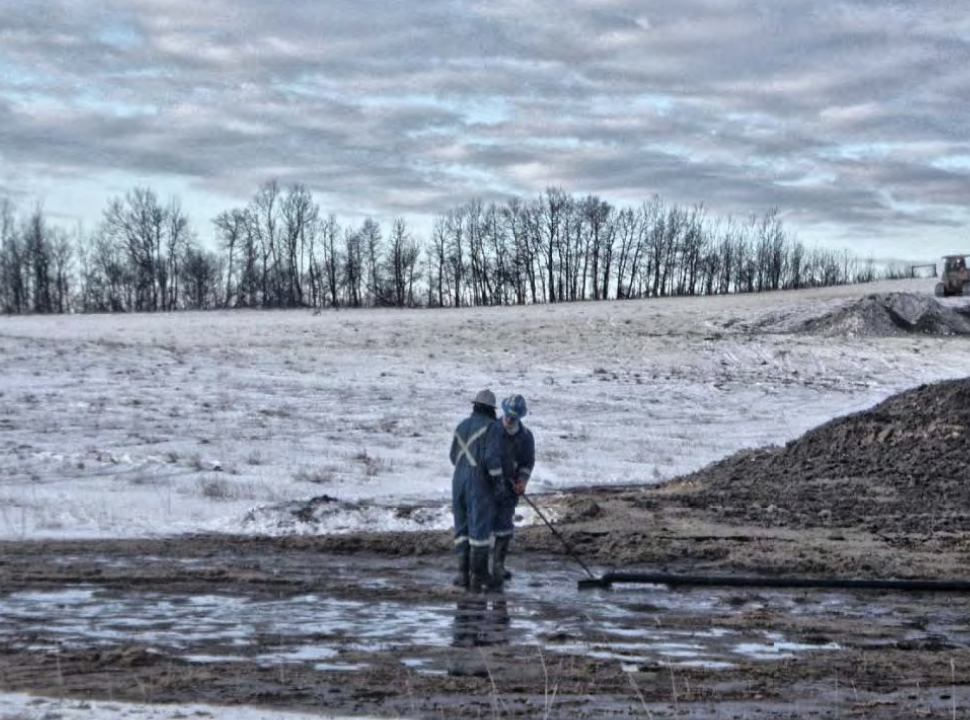
January 13, 2012: Frack hit on farm near Innisfail, Alberta. Photo by Alberta Surface Rights Group
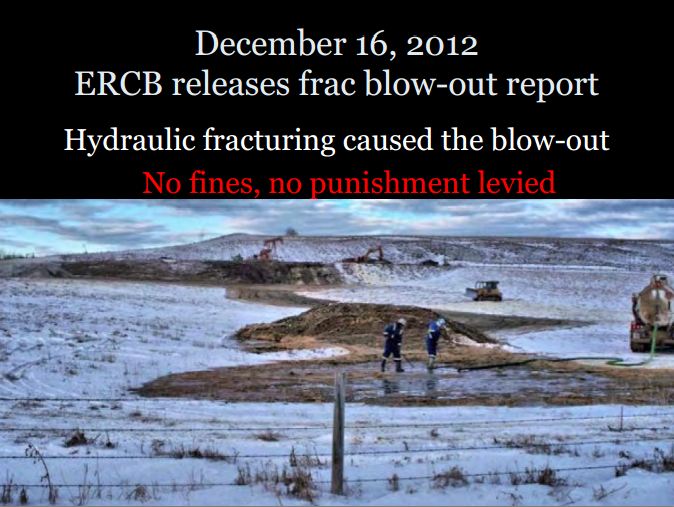
2012 01 23: ERCB (now AER): Interwellbore Communication During Fracturing Operation Events
2013 08 05: When 2 wells meet, spills can often follow
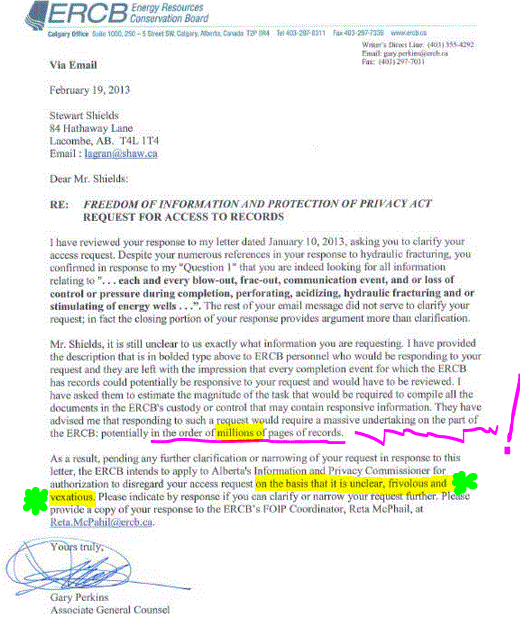
FOIP letter from AER (previously ERCB) on all fracks gone bad in Alberta, only to 2013!!
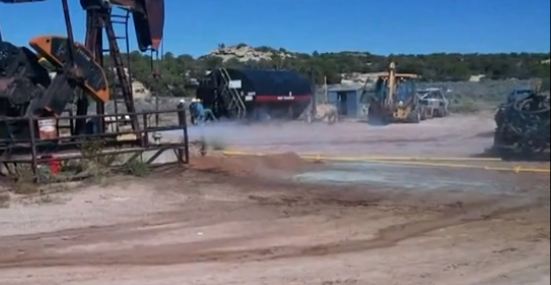
It can get pretty testy. Encana fracked somebody else’s well – in yet another case of “involuntary stimulation”
Canada steps up well monitoring to try to avoid ‘frack hits’
